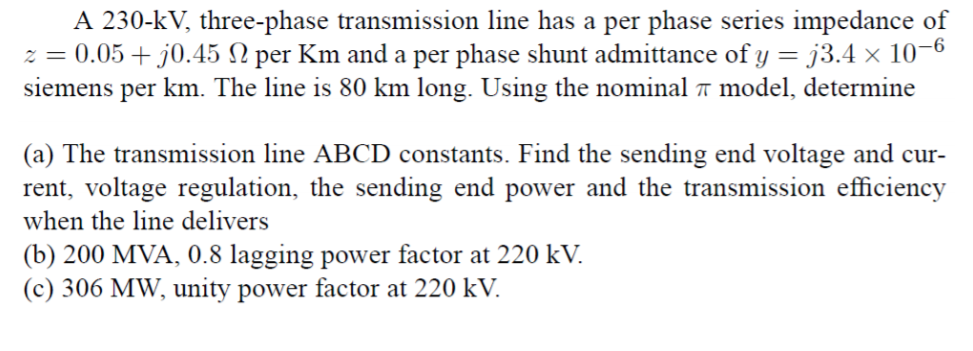A 230-kV, three-phase transmission line has a per phase series impedance of -6 per Km and a per phase shunt admittance of y 0.05 + j0.45 siemens per km. The line is 80 km long. Using the nominal π model, determine 73.4 x 10 (a) The transmission line ABCD constants. Find the sending end voltage and cur- rent, voltage regulation, the sending end power and the transmission efficiency when the line delivers (b) 200 MVA, 0.8 lagging power factor at 220 kV. (c) 306 MW, unity power factor at 220 kV
A 230-kV, three-phase transmission line has a per phase series impedance of -6 per Km and a per phase shunt admittance of y 0.05 + j0.45 siemens per km. The line is 80 km long. Using the nominal π model, determine 73.4 x 10 (a) The transmission line ABCD constants. Find the sending end voltage and cur- rent, voltage regulation, the sending end power and the transmission efficiency when the line delivers (b) 200 MVA, 0.8 lagging power factor at 220 kV. (c) 306 MW, unity power factor at 220 kV
Power System Analysis and Design (MindTap Course List)
6th Edition
ISBN:9781305632134
Author:J. Duncan Glover, Thomas Overbye, Mulukutla S. Sarma
Publisher:J. Duncan Glover, Thomas Overbye, Mulukutla S. Sarma
Chapter5: Transmission Lines: Steady-state Operation
Section: Chapter Questions
Problem 5.11P: A 40-km, 220-kV, 60-Hz, three-phase overhead transmission line has a per-phase resistance of...
Related questions
Question
100%
A 230-kV, three-phase transmission line has a per phase series impedance of .... (please see attached image).

Transcribed Image Text:A 230-kV, three-phase transmission line has a per phase series impedance of
-6
per Km and a per phase shunt admittance of y
0.05 + j0.45
siemens per km. The line is 80 km long. Using the nominal π model, determine
73.4 x 10
(a) The transmission line ABCD constants. Find the sending end voltage and cur-
rent, voltage regulation, the sending end power and the transmission efficiency
when the line delivers
(b) 200 MVA, 0.8 lagging power factor at 220 kV.
(c) 306 MW, unity power factor at 220 kV
Expert Solution
This question has been solved!
Explore an expertly crafted, step-by-step solution for a thorough understanding of key concepts.
This is a popular solution!
Trending now
This is a popular solution!
Step by step
Solved in 5 steps with 4 images

Knowledge Booster
Learn more about
Need a deep-dive on the concept behind this application? Look no further. Learn more about this topic, electrical-engineering and related others by exploring similar questions and additional content below.Recommended textbooks for you

Power System Analysis and Design (MindTap Course …
Electrical Engineering
ISBN:
9781305632134
Author:
J. Duncan Glover, Thomas Overbye, Mulukutla S. Sarma
Publisher:
Cengage Learning

Power System Analysis and Design (MindTap Course …
Electrical Engineering
ISBN:
9781305632134
Author:
J. Duncan Glover, Thomas Overbye, Mulukutla S. Sarma
Publisher:
Cengage Learning